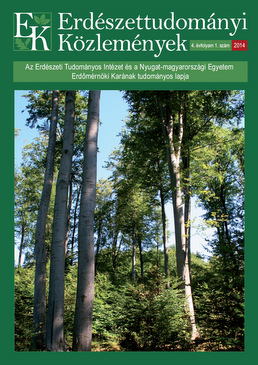Nationwide comparison of potential natural forest communities and current forest stands
Dénes Bartha, Márton Korda, Gábor Kovács & Gábor Tímár
Correspondence
Abstract
Results of nationwide analysis of Hungarian Forest Stand Database (date 01. 01. 2012.) have been presented in this publication. We defined the potential natural forest communities of all forest compartments by the method of site evaluation. Comparison of potential natural forest communities and current forest stands makes it possible the analyses of relationship between the potential and current forest communities nationwide. This study makes an attempt to discover the background of current forest communities surveying the site conditions and former landscape use of forest compartments.
Keywords: potential natural forest communities, current forest stands, rate of transformation, alien tree species
| 1. | ÁESZ 2004: Erdőrendezési Útmutató, Kódjegyzéke és Mellékletei. Állami Erdészeti Szolgálat, Budapest. |
| 2. | ÁESZ 2005: Az egyes termőhelytípus-változatokon alkalmazható célállományok. Állami Erdészeti Szolgálat, Budapest. |
| 3. | Bartha D. 2001: Veszélyeztetett erdőtársulások Magyarországon. WWF füzetek 18, WWF Magyarország, Budapest. |
| 4. | Bartha D. 2005: Tájállapotok és vegetációállapotok, mint az erdőtermészetességi vizsgálatok viszonyítási alapjai. Tájökológiai Lapok, 3(2): 253-274. full text |
| 5. | Bartha D. és Esztó P. 2001: Az Országos Erdőrezervátum-hálózat bemutatása az Országos Erdőállomány-adattár alapján. ER, Az erdőrezervátum-kutatás eredményei, 1 (1): 21-44. |
| 6. | Bartha D.; Kovács G. és Tímár G. 2005: A kis részarányú termőhelytípus-változatokhoz rendelhető természetes erdőtársulás-csoportok. Kézirat, Sopron. |
| 7. | Bartha D. 2013: Természetvédelmi élőhely-ismeret. Mezőgazda Kiadó, Budapest. |
| 8. | Bölöni J. 2001: Főbb erdőtársulás-csoportok részaránya az Országos Erdőrezervátum-hálózatban. ER, Az erdőrezervátum-kutatás eredményei, 1(1)45-52. |
| 9. | Jakucs P. 1981: Magyarország legfontosabb növénytársulásai. 225-263. In: Hortobágyi T. és Simon T. (szerk): Növényföldrajz, társulástan és ökológia. Tankönyvkiadó, Budapest. |
| 10. | Zólyomi B. 1989: Természetes növénytakaró. Térkép. In: Pécsi M. (szerk.): Magyarország nemzeti atlasza. Kartográfiai Vállalat, Budapest. |
ÁESZ 2004: Erdőrendezési Útmutató, Kódjegyzéke és Mellékletei. Állami Erdészeti Szolgálat, Budapest. ÁESZ 2005: Az egyes termőhelytípus-változatokon alkalmazható célállományok. Állami Erdészeti Szolgálat, Budapest. Bartha D. 2001: Veszélyeztetett erdőtársulások Magyarországon. WWF füzetek 18, WWF Magyarország, Budapest. Bartha D. 2005: Tájállapotok és vegetációállapotok, mint az erdőtermészetességi vizsgálatok viszonyítási alapjai. Tájökológiai Lapok, 3(2): 253-274. full text Bartha D. és Esztó P. 2001: Az Országos Erdőrezervátum-hálózat bemutatása az Országos Erdőállomány-adattár alapján. ER, Az erdőrezervátum-kutatás eredményei, 1 (1): 21-44. Bartha D.; Kovács G. és Tímár G. 2005: A kis részarányú termőhelytípus-változatokhoz rendelhető természetes erdőtársulás-csoportok. Kézirat, Sopron. Bartha D. 2013: Természetvédelmi élőhely-ismeret. Mezőgazda Kiadó, Budapest. Bölöni J. 2001: Főbb erdőtársulás-csoportok részaránya az Országos Erdőrezervátum-hálózatban. ER, Az erdőrezervátum-kutatás eredményei, 1(1)45-52. Jakucs P. 1981: Magyarország legfontosabb növénytársulásai. 225-263. In: Hortobágyi T. és Simon T. (szerk): Növényföldrajz, társulástan és ökológia. Tankönyvkiadó, Budapest. Zólyomi B. 1989: Természetes növénytakaró. Térkép. In: Pécsi M. (szerk.): Magyarország nemzeti atlasza. Kartográfiai Vállalat, Budapest.
For non-commercial purposes, let others distribute and copy the article, and include in a collective work, as long as they cite the author(s) and the journal, and provided they do not alter or modify the article.
Cite this article as:
Bartha, D., Korda, M., Kovács, G. & Tímár, G. (2014): Nationwide comparison of potential natural forest communities and current forest stands. Bulletin of Forestry Science, 4(1): 7-21. (in Hungarian)

Volume 4, Issue 1
Pages: 7-21
First published:
15 July 2014
More articles
by this authors
